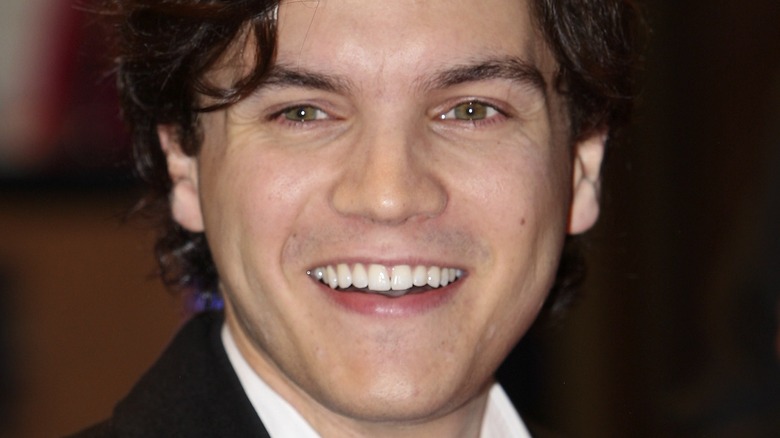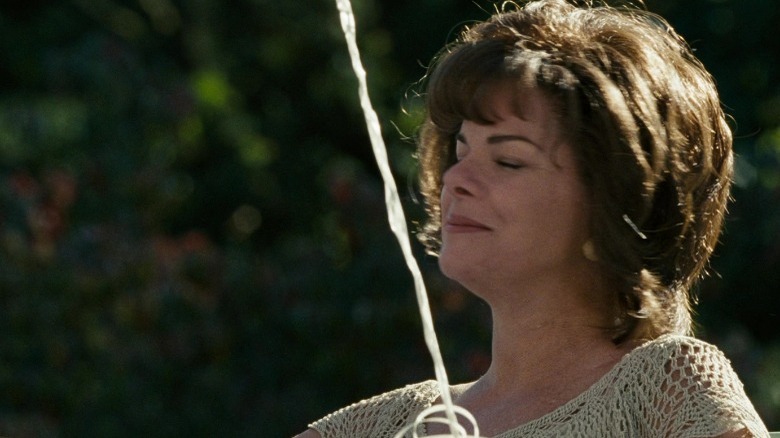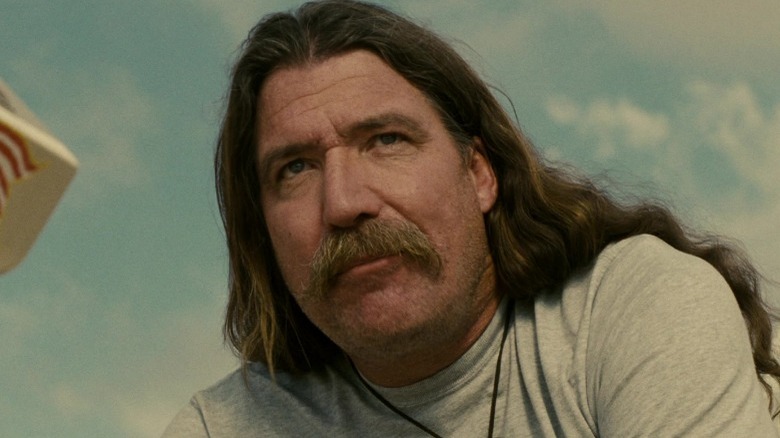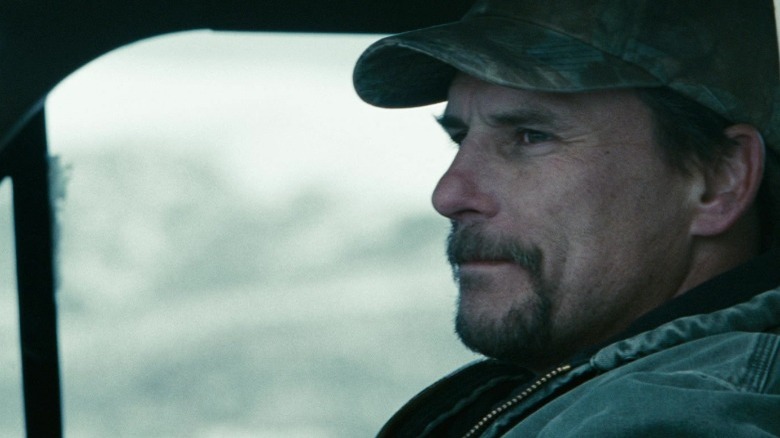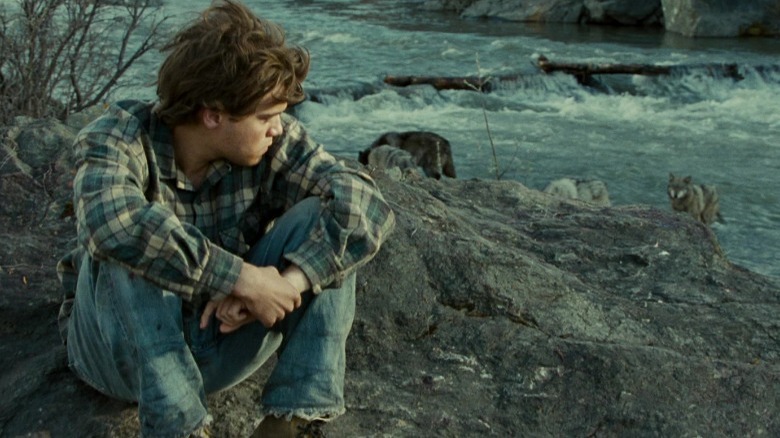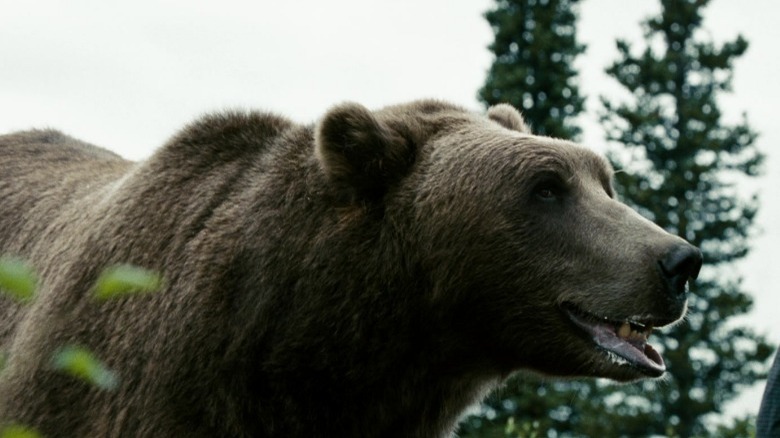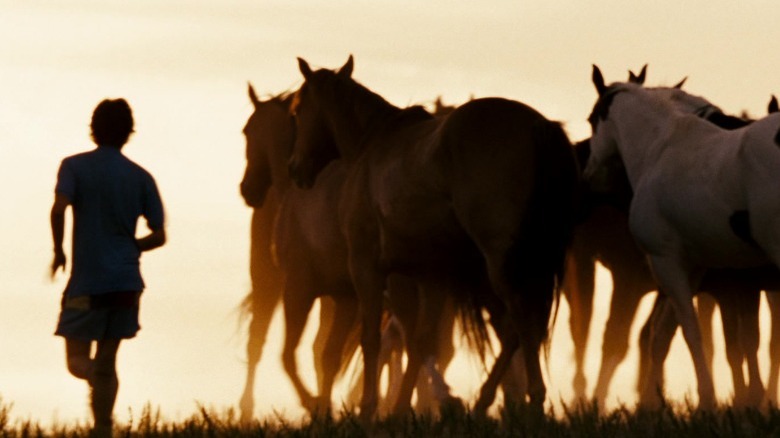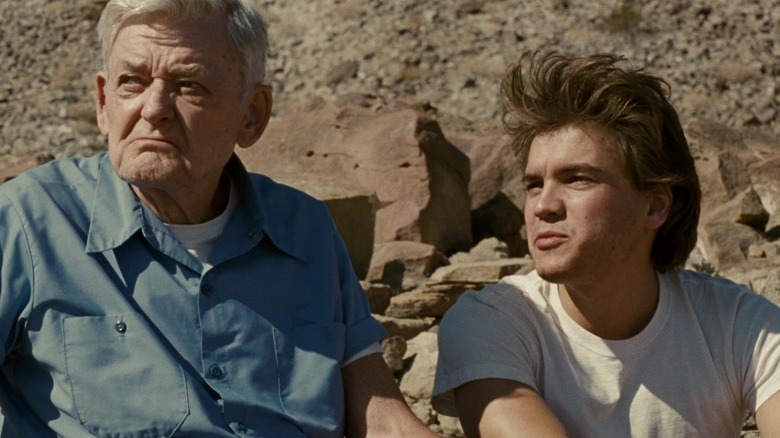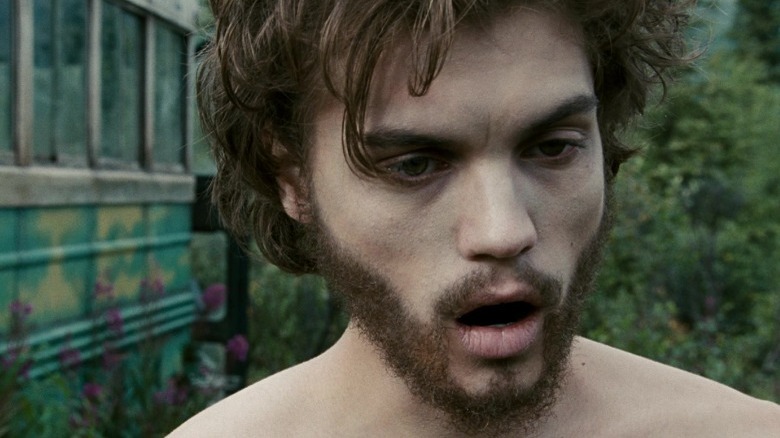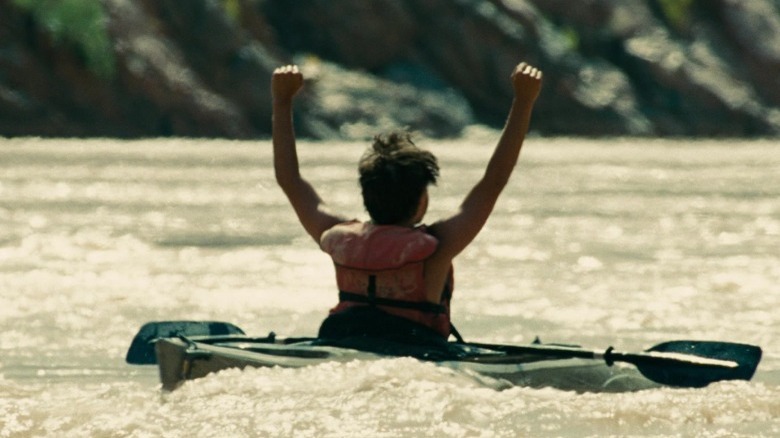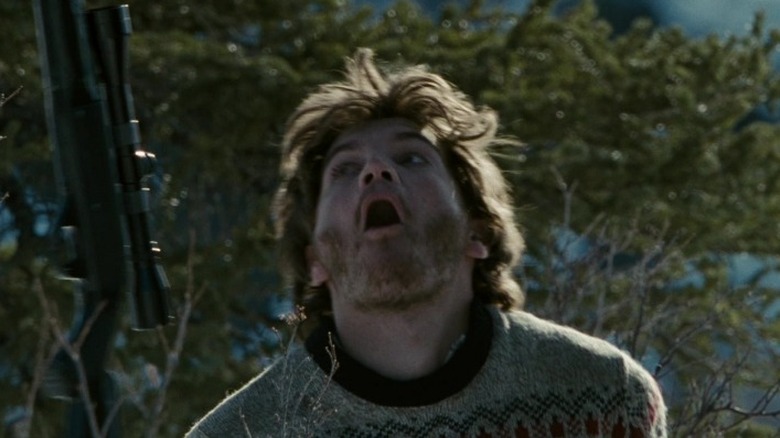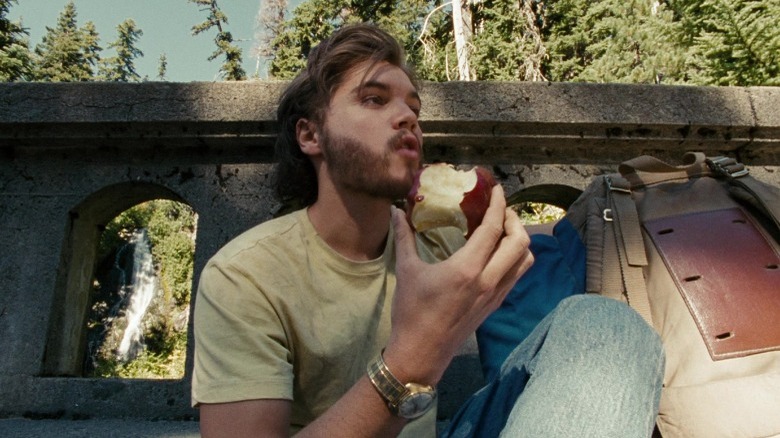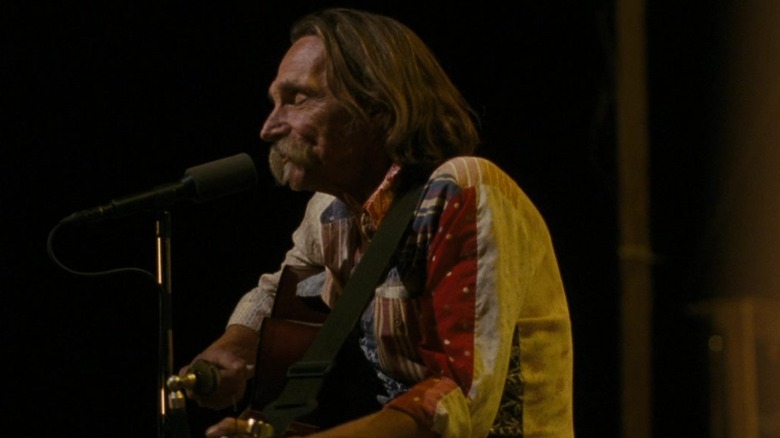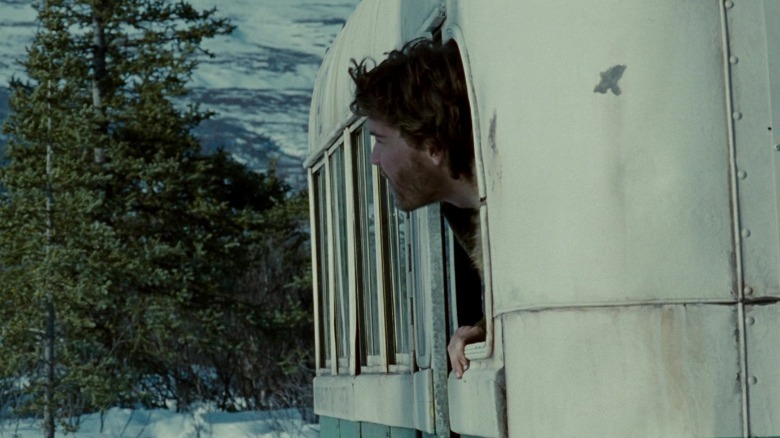The Untold Truth Of Into The Wild
In April 1992, when Chris McCandless wrote the phrase "Magic Bus" in his journal, he was not referring to the Magic School Bus. (Much as we would love to say otherwise, Miss Frizzle isn't real.) Instead, McCandless was referring to Bus 142, a rusty old construction bus that had been abandoned in the middle of the Alaskan wilderness (via GreenBelly). To McCandless, who had given up all his worldly possessions and had hitchhiked across the American countryside hoping to live off the land, Bus 142 must have seemed like a sign from the universe. As a result, the "Magic Bus" was where McCandless set up camp, and it was where he would ultimately die, because the 24-year-old was inexperienced and poorly-equipped to survive the harsh environment.
After his death, McCandless made national headlines. Jon Krakauer researched his adventures and published them in a book called "Into the Wild." Later, it was adapted into a movie of the same name, directed by Sean Penn and starring Emile Hirsch as McCandless. Many critics consider the film to be one of the best movies about people surviving in the wilderness.
If you want to explore further, we've compiled the most fascinating stories behind the movie based on this stranger-than-fiction tale.
Sean Penn waited almost a decade to get the movie rights
Whenever it was that Sean Penn picked up a copy of the 1996 book "Into the Wild," the story of Chris McCandless immediately resonated with him. "I ended up reading it cover to cover, nonstop, twice — the first time realizing it was a movie and the second time affirming it," Penn explained in an interview (via SF Gate).
However, there was one crucial hurdle preventing him from turning it into a movie. McCandless's family — his parents Billie and Walt and his sister Carine — weren't sure if they wanted their son's tragedy to be portrayed on the big screen. "They were being pursued by several others [who wanted to make a movie]," Penn told SF Gate. "But the wounds were still very fresh." It seemed like the possibility of a movie adaptation had been put permanently to rest, according to CBS News, after Billie told Penn that she had a dream of her son telling her, "Don't make a movie about me." Penn, of course, respected her wishes. "I told her if I didn't respect dreams, I wouldn't make movies," he said.
Penn would wait almost 10 years. "Some part of me never believed that it wouldn't be made," he admitted to SF Gate. Yet one day Billie called Penn and told him she was ready to see her son's story told. Penn wasted no time getting started on what would become the movie "Into the Wild."
Most of the characters were based on real people
Almost all the cast members in "Into the Wild" portray real-life people. Obviously, McCandless's sister (played by Jena Malone) and parents (played by Marcia Gay Harden and William Hurt) are real people. But the real Chris McCandless also met Jan Burres (Catherine Keener) and her boyfriend (played by Brian Dierker) — not once, but twice. Just like in the movie, Jan was reunited with McCandless after spotting his backpack in The Slabs (via The Joplin Globe).
McCandless did indeed meet grain elevator operator Wayne Westerberg (Vince Vaughn), and he really did send Westerberg a postcard (published in Oprah) right before his fateful trip into the wilderness. In fact, it is from this postcard that the movie draws its title. And if you recall the character at the beginning of the movie who drops McCandless off in Alaska and urged McCandless to call him back, that was a real person, too: a man named Jim Gallien.
In an interview with MovieWeb, Kristen Stewart explained, "My character [Tracy Tatro] is definitely based on a girl [that McCandless met and Sean Penn interviewed]," though she added that Penn took some creative liberties to make the character better fit his vision for the movie. Likewise, Ron Franz (Hal Holbrook) is a real person, though Holbrook told NPR that he added his own interpretation of the character. According to A.V. Club, the only major characters who didn't have any real-life basis were the Danish tourists Sonja (Signe Egholm Olsen) and Mads (Thure Lindhardt).
Three people McCandless met were on the movie crew
While Jan Burres and many of the other characters in the movie were portrayed by actors, many of the extras are ordinary people with no acting experience. According to The Hollywood Reporter, the filmmakers cast residents of the hippie enclave Slab City as background characters; meanwhile, the homeless characters in Los Angeles were real homeless people paid to play extras. In fact, there are actually three people who met Chris McCandless that directly participated in creating the film.
Wayne Westerberg — the real Westerberg, not the character portrayed by Vince Vaughn — was a member of the film crew. According to the cast list on IMDB, he was a driver working in the transportation department and was given special thanks as a consultant. In addition, country music singer Insane Cain is played by a real-life performer named Insane Wayne. What's more, eagle-eyed viewers will notice that another friend of McCandless gets a cameo in the movie. At Sean Penn's insistence, the movie recruited the real-life Jim Gallien to play himself.
As Jon Krakauer explains in the book "Into the Wild" (via Oprah), Gallien was the last person to see McCandless before he plunged into the wilderness alone. In the movie, Gallien "drops [Hirsch] off at the same spot he really dropped [McCandless] off," executive producer John Kelly explained to The Hollywood Reporter. Clearly Penn knew that asking the real Gallien to re-enact this small but crucial moment in McCandless's story would make the movie even more poignant.
People have died attempting to follow McCandless's footsteps
"Into the Wild" is in many ways an uplifting movie that will inspire viewers to blaze new trails. But it's also a cautionary tale, since McCandless's refusal to accept help from anyone ultimately leads to his demise. Still, that doesn't dissuade hikers from around the globe from attempting to take the same path Chris McCandless took. Unfortunately, a few such hikers have died in the process.
For instance, a tourist from Belarus named Veranika Nikanava drowned while trying to cross the Teklanika River, the same river that McCandless crossed (via Reuters). Nikanava had been trying to reach Bus 142 when the fast-moving river carried her off. Meanwhile, 18-year-old Johnathan Croom wasn't anywhere near the spot where McCandless had been; Croom's body was found in the Oregon countryside. However, Croom was likely inspired by "Into the Wild," since the boy's father, David Croom, told Outside Online that his son had been fascinated by the movie before his death. David speculated that this was why his son went into the wilderness alone.
Journalist Eva Holland mused in an interview with CBC that these deaths would only encourage more tourists to try traveling out to Bus 142. "People like to feel like they're taking a risk," she said. "Sometimes this kind of thing can draw people in rather than push them away."
Training the animals for the movie was difficult
The movie encountered quite a few hurdles with its trained animals. For instance, the filmmakers felt pretty confident about the wolves that their animal trainers had brought up to Alaska — at least until they needed to start shooting. According to Men's Journal, the crew quickly discovered that the trained wolves were too well-behaved and didn't act like wild wolves. Alaskan resident Tim Kiehl, who assisted with production, knew right away that these wolves weren't cut out for the job. "They looked like dogs, not real wolves," he told Detroit Lake Online. "[The film crew] ended up getting some real wolves, from a guy that had a place north of Anchorage."
The wolves weren't the only hassle. The crew of "Into the Wild" ran into some trouble with their trained grizzly (played by Bart the Bear II) when he ended up on the wrong side of the river. The filmmakers seriously considered airlifting him, though thankfully they didn't need to take such drastic action (via Men's Journal). Emile Hirsch told Emory Report that shooting the scene with the bear was both the best and the worst day of production for him. Hirsch admitted he was rather intimidated by the grizzly: "Even though he was trained, he was a method actor — very prone to improvising." But he added that finishing the day with all of his arms and legs also made it the high point of the shoot.
The movie was filmed (mostly) on location
Although the original plan for "Into the Wild" was to base the production in Vancouver or Salt Lake City and shoot there, Sean Penn had something different in mind. Executive producer John Kelly told The Hollywood Reporter that Penn had decided, "We're going to go to South Dakota, we're going to go to Emory University (in Atlanta) — we're going to shoot these places the way they happened." Since McCandless's parents had recovered their son's camera, full of undeveloped photos of his trip, the filmmakers used those photos (along with Krakauer's book) as a basis for where they would shoot. The journey took Penn and his team to places like Carthage, South Dakota and the Salton Sea in California. "It just felt like the only way to make the movie," Penn told Men's Journal. By the time the film was finished, Penn had shot at 35 separate locations, according to Glide magazine.
However, there was one notable exception to Penn's goal of shooting where McCandless had been. Rather than filming at the actual location of Bus 142, Penn and his crew filmed 50 miles south in the town of Cantwell, because the place where McCandless died was too remote to send a whole film crew and Cantwell was arguably more picturesque. The crew recreated Bus 142 for the film by restoring an identical model they'd found in a junkyard.
Jon Krakauer was worried Sean Penn would ruin the movie
"Into the Wild" was not the first book by Jon Krakauer to get the movie treatment. In fact, Krakauer's firsthand account of a disaster on Mount Everest, "Into Thin Air," was the basis for two different films. However, "Into the Wild" was the first movie adaptation that Krakauer actually liked.
Krakauer told Indiewire that the 1997 TV movie "Into Thin Air: Death on Everest," pretty much ruined him for wanting to see his books adapted into movies ever again. Krakauer said, "They asked me to be a consultant and they didn't listen to any of my consulting and it was awful." His experience was even worse with the 2015 movie "Everest." According to Outside Online, director Baltasar Kormákur didn't even bother reaching out to Krakauer (at least not directly), even though Michael Kelly was going to be portraying a fictionalized version of the author. Krakauer's assessment of the movie was blunt: "It's total bull," he told The Los Angeles Times.
So it's all the more significant that Krakauer loved the movie version of "Into the Wild." Certainly, he feared the worst at first. Krakauer explained to the Los Angeles Times that he didn't get the chance to visit the set until the last day of production. He warned the director, "Sean, if you [screw] this up, I don't want you to say I was there." Thankfully, Krakauer was pleasantly surprised. "When [Penn] showed me the rough cut," said Krakauer, "I wanted to kiss him, I was so happy."
The movie version of McCandless's death was almost disproven
The movie "Into the Wild" leaves no ambiguity surrounding McCandless's death: he ate poisonous wild potato seeds that made him too weak to gather food, so he starved. This theory came directly from Krakauer's book. For years there had been some serious debate that the book and the movie had gotten it wrong. However, after some additional research, Krakauer was able to conclude in a 2015 New Yorker article that his initial hypothesis had been right; he'd just gotten a few of the details wrong.
Initial research certainly pointed to the seeds as the culprit. After all, McCandless's journal (via Outside Online) said, "Extremely weak. Fault of pot[ato] seed." But after Krakauer's book had been published, chemist Thomas Clausen ran some additional tests on the seeds and decided there wasn't enough proof behind the theory. "I tore that plant apart," he told Men's Journal. "There were no toxins. No alkaloids. I'd eat it myself." According to The New Yorker, Krakauer collaborated with Avomeen Analytical Services to investigate Clausen's findings and confirmed there were no toxic alkaloids in the seeds. But maybe, Krakauer speculated, there was another kind of toxin. Sure enough, he discovered a toxic amino acid called L-canavanine that was present in the seeds and thus responsible for McCandless's death.
Therefore, the movie got it right — although the scenes where McCandless flips through his botany book and notices his mistake are technically inaccurate, since nobody knew at the time that the seeds could be poisonous.
Emile Hirsch did his own stunts in the rapids
Sean Penn is a very committed director. Emile Hirsch has described the man as "the general with the mad glint in his eye [who] inspires people around him to do their best" (via Emory Report).
Case in point: Penn made Hirsch do all his own stunts, according to Groucho Reviews. The actor, who had never been in a kayak in his life, discovered that Penn wanted him to do the kayaking scene himself, rather than getting a stunt double. In an interview with CBS News, Hirsch recalled Penn asking him, "If I do it first, will you do it?" Then Penn plunged right into the rapids to show Hirsch it could be done. Hirsch decided that if his director was willing to do it, then it couldn't be all that bad. After watching Penn, Hirsch thought, "Well, now I gotta." No acting was required for the scene in the rapids; in fact, acting was the last thing on Hirsch's mind. "I just wanted to stay afloat and not suck water," he told The Gadsden Times.
According to Hirsch, working on the movie taught him that he could do (almost) anything if he set his mind to it. He told Emory Report, "It's only your own fears that are holding you back."
Not everyone idolizes McCandless as a tragic hero
When most people think of Chris McCandless, they think of him with reverence, and that is largely thanks to the image of him immortalized in the movie and the book. The movie portrays McCandless in a romantic light, though it does acknowledge his fatal flaw: refusing any help and deciding to "go it alone." However, not everyone shares this rosy view of the young man. In fact, many Alaskans view him as a newbie who bit off more than he could chew.
For instance, Alaskan journalist Craig Medred has described McCandless as "Alaska's most famous nobody." Meanwhile, park ranger Peter Christian wrote an essay (shared on the blog of travel memoirist Ken Ilgunas) that condemned McCandless's actions as "[not] even particularly daring, just stupid, tragic and inconsiderate." Men's Journal interviewed Butch Killian, one of the moose hunters who found McCandless dead in the wilderness. It turned out that Killian was only vaguely familiar with Jon Krakauer's book about McCandless, and he was surprised to learn that the book was so popular. He couldn't understand why folks placed McCandless on a pedestal. "If he's a hero," said Killian, "he's a dead hero."
Hirsch wears McCandless's actual watch in the movie
To lend even more authenticity to "Into the Wild," Emile Hirsch wore a very special accessory: the watch worn by the real Chris McCandless before he died (per The East Bay Times).
McCandless's watch hadn't been recovered from his body because he wasn't wearing it when he died. Instead, the film crew got the timepiece from Jim Gallien, whom McCandless had bestowed with the watch right before he set off into Denali National Park. In an interview for Jon Krakauer's book (via Oprah), Gallien recalled that McCandless had told him to keep the watch, along with his comb and all the loose change he had been carrying. As far as McCandless was concerned, he wouldn't need any of these things where he was going. "I don't want to know what time it is," McCandless reportedly told Gallien. "I don't want to know what day it is or where I am. None of that matters." Gallien felt wrong accepting these items, but the boy merely insisted he would throw them away if Gallien didn't take them.
Hirsch told The East Bay Times that Gallien had hung onto that watch for more than a decade, and when the man learned Hirsch would be portraying McCandless in the movie, he let the actor wear it.
Penn brought a man out of jail to film a scene
Sean Penn waited almost 10 years to create "Into the Wild," so it's easy to understand why he'd be willing to bend a few rules to make sure the movie would finally happen. Still, it's certainly surprising that the director had so much sway that he managed to get permission to borrow somebody from jail for a day.
The person in question was Everett "Insane Wayne" Smith (called "Insane Cain" in the movie), a resident of The Slabs who attend the same country music concert as McCandless. Emile Hirsch explained that Penn had met Insane Wayne on his initial research trip to The Slabs and wanted to include Wayne in the movie. No doubt he was disappointed to learn on the day of shooting that Wayne had been arrested for domestic violence charges (per LA Weekly). Penn persuaded a local judge to temporarily release Wayne, just so he could film a cameo in the movie. According to Hirsch, "[Insane Wayne] showed up on that day in full handcuffs and an orange jumpsuit and sheriffs with shotguns. They briefly let him put on his costume and sing a song." Some 14 hours later, after the scene was filmed, Insane Wayne returned to jail.
If you or someone you know is dealing with domestic abuse, you can call the National Domestic Violence Hotline at 1−800−799−7233. You can also find more information, resources, and support at their website.
Bus 142 has become a shrine to Chris McCandless
The rusted vehicle that Chris McCandless dubbed the "Magic Bus" quickly became a memorial to McCandless and a popular tourist destination. Hikers from the U.S., Finland, and even the Czech Republic have made the trek to Bus 142, says Men's Journal. Some of the real-life people portrayed in "Into the Wild," including McCandless's sisters and Jan Burres, have made pilgrimages to the bus. "It amazes me how many people have come up here to pay homage to him," Burres shared in a clip posted on YouTube while standing outside Bus 142.
However, hikers can no longer find Bus 142 in the Alaskan wilderness. After two deaths near the bus and countless other tourists that needed to be rescued, the Alaskan National Guard decided the bus was becoming a safety hazard (via The Daily Mail). So in June 2020, they airlifted Bus 142 to an undisclosed safe location. According to The Anchorage Daily News, Alaska's Museum of the North intends to display the bus in an outdoor exhibit. Once the restoration of the bus is complete, tourists will be able to more easily visit the "Magic Bus" where the journey of Chris McCandless ended.
